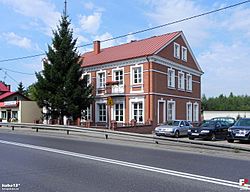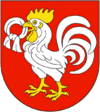Kurów facts for kids
Quick facts for kids
Kurów
|
||
|---|---|---|
|
Village
|
||

Old Commune Hall
|
||
|
||
 |
||
| Country | ||
| Voivodeship | ||
| County | Puławy | |
| Gmina | Kurów | |
| Established | probably 12th century | |
| City rights | 1442–1870 | |
| Area | ||
| • Total | 11.33 km2 (4.37 sq mi) | |
| Elevation | 157 m (515 ft) | |
| Population
(31.12.2018)
|
||
| • Total | 2,725 | |
| • Density | 241/km2 (620/sq mi) | |
| Time zone | UTC+1 (CET) | |
| • Summer (DST) | UTC+2 (CEST) | |
| Postal code |
24-170
|
|
| Area code(s) | +48 81 | |
| Car plates | LPU | |
Kurów (pronounced 'kuh-roof') is a village in south-eastern Poland. It is located in a historical area called Lesser Poland. You can find it between the cities of Puławy and Lublin, right on the Kurówka River.
Kurów is the main town of its own local government area, known as Gmina Kurów. This area is part of the Lublin Voivodeship, which is like a large region or province in Poland. In 2018, about 2,725 people lived in the village.
Contents
History of Kurów
Kurów was likely first mentioned in an old Polish book around the 12th century. The earliest clear record of the village is from 1185. This document talks about a church dedicated to Saint Giles already being there.
Between 1431 and 1442, Kurów was given special "city rights." This meant it could act like a town, following rules known as the Magdeburg Law. As a private town, it became an important place for trading food from the nearby farms. There were also factories that made things from fur and leather.
In the 1500s, Kurów became a center for a Christian group called Calvinism. Many members of another group, the Polish Brethren, moved there. By 1660, most people in Kurów had changed their beliefs to Arianism. At this time, Kurów was one of the most important towns in the Lublin Voivodeship.
Kurów in Changing Times
After 1660, Kurów's history followed the rest of its region. In 1795, Poland was divided by other countries in events called the Partitions of Poland. Kurów then became part of Austria.
Later, in 1809, it joined the Duchy of Warsaw, a small Polish state. In 1815, Kurów became part of the Kingdom of Poland. During the November Uprising in 1831, Polish forces led by General Józef Dwernicki won a small battle against the Russian army in Kurów.
However, in 1870, after another uprising called the January Uprising, Kurów lost its city rights. It has been a village ever since. Since 1918, after Poland became independent again, Kurów has been part of Poland.
World War II and Kurów
On September 9, 1939, World War II began with the Polish Defensive War. During this time, German planes, known as the Luftwaffe, heavily bombed Kurów. A civilian hospital, clearly marked with red crosses, was destroyed, and many people were harmed.
During the war, Germany set up two camps in Kurów where people were forced to work. In 1942, a small ghetto was created. This was a special area where Jewish people were forced to live. However, many Poles who were held in Kurów managed to escape. They joined Polish resistance groups, like the Home Army, hiding in the nearby forests.
Jewish Community in Kurów
Before World War II began, about 2,600 Jewish people lived in Kurów. During the war, many Jewish people in Kurów lost their lives. The local synagogue, a Jewish place of worship, was badly damaged.
In June 1941, a ghetto was formed, and Jewish people were not allowed to leave Kurów. In April or May 1942, most of Kurów's Jewish residents were forced to march to another town. From there, they were put on trains and taken to Sobibor, a concentration camp.
Some Jewish people from Kurów managed to survive the first selections at Sobibor. These survivors helped to plan and carry out a revolt at the camp. This brave act led to the camp being destroyed by the Germans themselves.
While some Polish Christians reported Jewish people to the Germans, others bravely helped to hide and save many Jewish people from Kurów. Among those recognized for their help were Mieczysław Kutnik, Adam Turczyk, Wacław Mańko, and Andrzej and Katarzyna Zarzycki. The Zarzyckis were later honored as "Righteous Among the Nations" for their courage. A few hundred Jewish people from Kurów survived the war.
Before World War II, many Jewish residents of Kurów moved to other countries. They found new homes in places like America, Israel, Argentina, and France.
Old Buildings and Places to See
Kurów has several interesting old buildings and historical spots:
- St. Michael's Church: This church was built in 1452 and fixed up in 1692. It has the grave of the Zbąski family and sculptures made by Santi Gucci in 1587.
- Bell Tower: Built in the 1700s.
- Gate: Built in 1911.
- Rectory: This building, where the priest lives, was built between 1778 and 1782.
- Vicar's Building and Parish School: These buildings were also part of the church complex.
- World War I Cemetery: A place where soldiers from World War I are buried.
- Commune Hall: This building, used for local government, was built in the 1800s.
- Post Office: Built in the 1700s.
- Thermae: A type of old public bath, built in the 1800s.
- Various Monuments: There are also other monuments around the village.
Transport in Kurów
Since 2013, the S12 and S17 expressways run north of Kurów. These modern roads help traffic traveling between Lublin and Warsaw to go around the village, making travel smoother.
Sport Clubs in Kurów
Kurów has a few local sports clubs:
- KKS Garbarnia: This club plays football and futsal (a type of indoor football).
- KTS Topspin: A club for table tennis.
- Kur-Team: This group enjoys nordic walking, which is walking with poles.
- OSP: This club is involved in fire-fighting sports.
Notable People from Kurów
Several important people have connections to Kurów:
- Wojciech Jaruzelski: Born in Kurów in 1923, he was a general and a leader during the communist era in Poland. He passed away in Warsaw in 2014.
- Czesław Janczarski: A poet and writer of fairy tales for children. He was born in 1911 and died in Warsaw in 1971.
- Klemens Kurowski: A Polish nobleman and senator who owned Kurów. He was born around 1340 and died before 1405.
- Grzegorz Piramowicz: A priest in Kurów, who was also a writer and philosopher. He was born in 1735 and died in 1801.
- Ignacy Potocki: A nobleman who owned Kurów. He was born in 1750 and died in Vienna in 1809.
Images for kids
See also
 In Spanish: Kurów para niños
In Spanish: Kurów para niños






